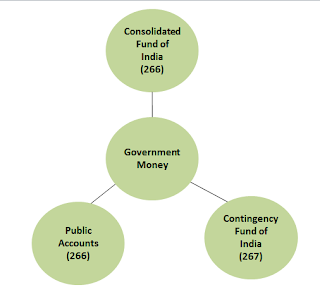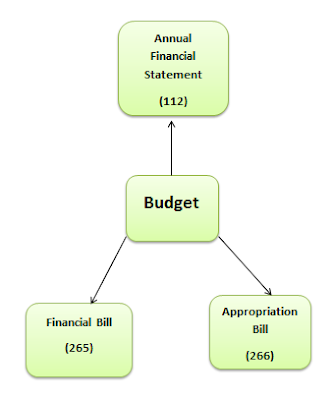INDIAN ECONOMY: THE UNION BUDGET
The Finance Minister
tables Ten to Twelve
documents on the Budget day. The Annual Financial Statement is the most important and main
document amount that.
“A government budget is
an annual financial statement showing item wise estimates of expected revenue
and anticipated expenditure during a fiscal year,that is often often passed by
the legislature, approved by the chief executive or president and presented by
the Finance Minister to the nation”.
Budget prepared by Department of Economic Affairs
Annual Financial Statement
Article 112 of the Constitution requires the government to present a statement of estimated receipts and expenditure in respect of every financial year - April 1 to March 31 to Parliament.
Article 112 of the Constitution requires the government to present a statement of estimated receipts and expenditure in respect of every financial year - April 1 to March 31 to Parliament.
The annual
financial statement -10-page white document.
Three parts: Consolidated Fund, Contingency Fund and
Consolidated Fund
- All revenues received by the government of india by way of taxes like Income Tax, Central Excise Tax, Customs & other receipts flowing to the government in connection with the conduct of government business.
- Non-tax revenues are credited into the consolidated fund constituted under article 266(1) of the Constitution of India.
- All loans raised by the government by issue of public notifications, treasury bills(internal debt) and loans obtained from foreign governments & international institutions (external debt) are credited into consolidated fund.
- No money can be withdrawn from this fund without the Parliament's approval.
Public Accounts of India (Article 266)
- All public money other than those which are credited to the consolidated fund of India received by or on behalf of government of India shall be credited to public account of India.
Public
Accounts of India includes….
Provident
fund deposits,judicial deposits,remittances etc..
· National Investment
fund (NIF) – Money earned from disinvestment.
· National Calamity
& contingency fund (NCCF) (Under Home ministry) ,now merged with National Disaster Relief Fund (NDRF).
· National small
savings fund, defence fund, provident fund, Postal insurance etc.
·
All Cess &
Specific purpose surcharges.
·
Government schemes
Fund (Eg. MNREGA)
|
- All money flowing into these funds is called receipts, the funds received, and not revenue.
- Account is operated by Executive action (ie;without parliamentary appropriation)
- Payments are mostly in the nature of banking transactions.
Contingency Fund (Art 267)
- Any urgent or unforeseen expenditure is met from this fund.
- The Parliament enacted the contiency fund of India Act in 1950.
- The Rs 500-crore fund is at the disposal of the President.
- Contingency fund is held by finance secretary on behalf of the President.
- Any expenditure incurred from this fund requires a subsequent approval from Parliament and the amount withdrawn is returned to the fund from the consolidated fund.
Current
year Budget’s Prominent part forms next year Annual Financial Statement(Statement
1)
Basis of Budget:
Annual Financial
Statement(Art.112) : Requires the
government to present to Parliament a statement of estimated receipts and
expenditure in respect of every financial year.
Financial
Bill(Art.265): To get permission of Parliament to Collect Taxes from
People.
Appropriation Bill(Art.266): To get permission of
Parliament, to take out cash from Consolidated Fund of India.
Budget at a Glance
Revenue Receipts =
Tax Revenue (Net to Centre) + Non-Tax Revenue.
Capital Receipts = Recovery
of Loans +Other Receipts +Borrowings
+Other
Liabilitites
Total Receipts = Revenue Receipts+ Capital Receipts.
Revenue Account = Interest
Payments+ Grants in Aid for creation of
capital assets.
Total Expenditure
= Revenue Account+Capital Account.
Revenue Deficit = Revenue Account- Revenue Receipts.
Effective Revenue
Deficit(ERD)= Revenue Deficit-Grants in Aid for
creation of capital assets.
Fiscal
Deficit = Total Expenditure-(Revenue
Receipts+Recovery of Loans + Other Receipts)
Primary Deficit = Fiscal
Deficit- Interest Payments.
Direct Taxes
Direct taxes are the one that fall directly on individuals and
corporations.Eg, Income Tax, Corporate Tax etc.
Indirect Taxes
Indirect taxes are imposed on
goods and services. They are paid by consumers when they buy goods and services.
These include excise duty, customs duty etc.
GST
The constitution defnes “Goods and Services Tax” as any tax on supply
of goods, or services or both except taxes on the supply of the alcoholic
liquor for human consumption. “Goods” means every kind of movable property
other than money and securities but includes actionable claim, growing crops,
grass and things attached to or forming part of the land which are agreed to
be severed before supply or under a contract of supply. “Services” means anything
other than goods, money and securities but includes activities relating to
the use of money or its conversion by cash or by any other mode, from one
form, currency or denomination, to another form, currency or denomination for
which a separate consideration is charged .
Customs Duty
These are levies charged when goods are imported into, or exported
from, the country, and they are paid by the importer or exporter. Usually,
these are also passed on to the consumer.
Fiscal policy
It is the government actions with respect to aggregate levels of
revenue and spending. Fiscal policy is implemented though the budget and is
the primary means by which the government can influence the economy.
Monetary Policy
This comprises actions taken by the central bank (i.e. RBI) to regulate the level of money or
liquidity in the economy, or change the interest rates.
Inflation
A sustained increase in the general price level. The inflation rate is
the percentage rate of change in the price level.
This is the tax paid by corporations or firms on the incomes they
earn.
Minimum
Alternative Tax (MAT)
The Minimum Alternative Tax is a minimum tax that a company must pay,
even if it is under zero tax limits.
Disinvestment
The sale of shares of public sector
undertakings by the Government. The shares of government companies held by
the Government are earning assets at the disposal of the Government. If these
shares are sold to get cash, then earning assets are converted into cash, So
it is referred to as disinvestment.
|
Some Important Terms in Budget
Charged Expenditures
§ ‘Charged’ upon the consolidated fund of India.
§ Non-votable by parliament(ie;it can be only discussed
by parliament).
§ Emoluments, allowances & expenditure of
President & his office
§ Salary & allowances of chairman ,Deputy
chairman of RS ,Speaker, Deputy speaker of Lok Sabha.
§ Debt charged for which GOI is liable.
§ Salary & allowances and pension of the chairman .and members of UPSC
§ Salaries, allowances & pensions of SC judges
& CAG.
§ pensions of HC judges.
§
Stages in Budget Enactment
1.
Presentation
of Budget
2.
General
Discussion
3.
Scrutiny
by Departmental Committees.
4.
Voting
on Demands for Grants.
5.
Passing
of Appropriate Bill.
6.
Passing
of Finance Bill
Vote on account
§ Power of Lok Sabha (not of Rajya sabha) to
authorize various ministries to incur expenditures for a part of financial
year, pending the passage of appropriation bill by the parliament.
Vote of Credit
§ Granted for meeting an unexpected demand upon the
resources of India, when on account of magnitude, the demand could not be
stated with details ordinarily given in the budget.
§ It is like a blank cheque given to the executive by
the Lower House.
Supplementary Grant
§ Granted when the amount authorized by parliament
through the appropriation act for a particular service for current financial
year is found to be insufficient for that year.
Additional Grant
§ Granted when a need has arisen during current
financial year for additional expenditure for some new service, not
contemplated in budget for that year
Excess Grant
§ Granted when money has been spent on any service
during a financial year in excess of amount granted for that service in the
budget for that year.
§ It is voted by Lok sabha after the financial year.
…………………………………………………………….............................












Good attempt to ease budget terminology and process.
ReplyDelete